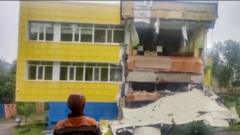The earthquake hit at approximately 11:25 AM local time on Wednesday (00:25 BST). Following the quake, Hawaii faced tsunami warnings leading to thousands heading to higher ground as waves measuring up to 1.7 meters were recorded. Hawaii's Governor Josh Green emphasized the dangers of the situation, stating, “It is not a regular wave. It will actually kill you if you get hit by a tsunami.” However, hours later, he reassured residents that no major tsunami had materialized. The Pacific Tsunami Warning Centre later downgraded Hawaii’s alert from warning to advisory.
In California, the National Tsunami Warning Centre recorded waves reaching 1.09 meters in Crescent City, while San Francisco experienced tidal surges of 0.7 meters. British Columbia issued a tsunami advisory before lifting it. In Russia, some buildings in Petropavlovsk-Kamchatsky suffered damage, but reports indicated no serious injuries following the reported tsunami waves that hit Severo-Kurilsk.
Meanwhile, Japan experienced similar sirens and evacuations with waves exceeding one meter on the Pacific coast. Prime Minister Shigeru Ishiba reassured citizens that, so far, no significant damage had been confirmed, even as workers at the Fukushima power plant were evacuated.
The earthquake, categorized as one of the strongest ever recorded, occurred within the Pacific Ring of Fire, an area known for its seismic activity. This ring accounts for 80% of the world's earthquakes. With aftershocks following the major quake, reports also noted initial lava flow from the Klyuchevskoy Volcano.
Residents across affected areas, now given the all-clear, are advised to remain vigilant and prepared for residual hazards while they assess the situation.
In California, the National Tsunami Warning Centre recorded waves reaching 1.09 meters in Crescent City, while San Francisco experienced tidal surges of 0.7 meters. British Columbia issued a tsunami advisory before lifting it. In Russia, some buildings in Petropavlovsk-Kamchatsky suffered damage, but reports indicated no serious injuries following the reported tsunami waves that hit Severo-Kurilsk.
Meanwhile, Japan experienced similar sirens and evacuations with waves exceeding one meter on the Pacific coast. Prime Minister Shigeru Ishiba reassured citizens that, so far, no significant damage had been confirmed, even as workers at the Fukushima power plant were evacuated.
The earthquake, categorized as one of the strongest ever recorded, occurred within the Pacific Ring of Fire, an area known for its seismic activity. This ring accounts for 80% of the world's earthquakes. With aftershocks following the major quake, reports also noted initial lava flow from the Klyuchevskoy Volcano.
Residents across affected areas, now given the all-clear, are advised to remain vigilant and prepared for residual hazards while they assess the situation.



















